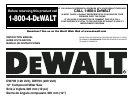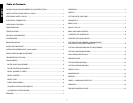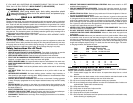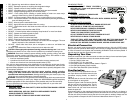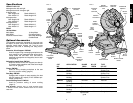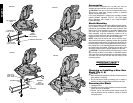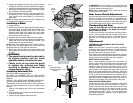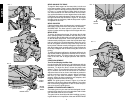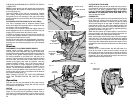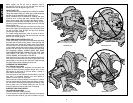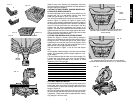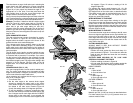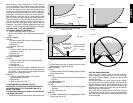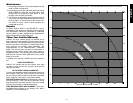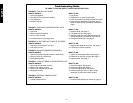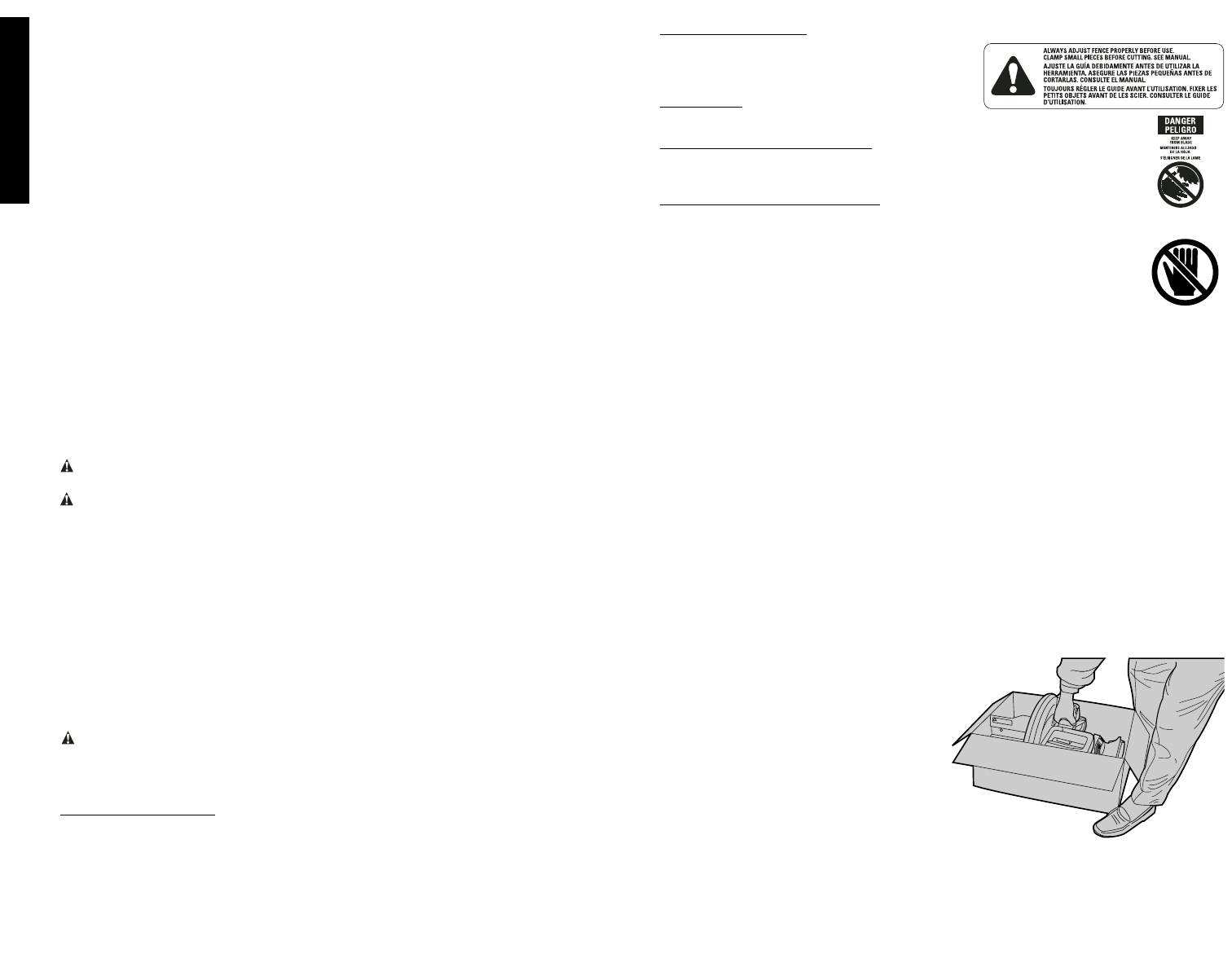
English
2
• DO - Support long work with an outboard tool rest.
• DON’T - Attempt to operate on anything but designated voltage.
• DON’T - Operate unless all clamp handles are tight.
• DON’T - Use blades larger or smaller than those which are recommended.
• DON’T - Wedge anything against fan to hold motor shaft.
• DON’T - Force cutting action. (Stalling or partial stalling of motor can cause major
damage. Allow motor to reach full speed before cutting.)
• DON’T - Cut ferrous metals (Those with any iron or steel content) or any masonry.
• DON’T - Use abrasive wheels. The excessive heat and abrasive particles generated by
them will damage the saw.
• DON’T - Allow anyone to stand behind saw.
• DON’T - Apply lubricants to the blade when it’s running.
• DON’T - Place either hand in the blade area when the saw is connected to the power
source.
• DON’T - Use blades rated less than 4800 R.P.M.
• DO NOT - Cut small pieces without clamping. Keep hands 6” or more from blade.
• DON’T - Operate saw without guards in place.
• DON’T - Perform any operation freehand.
• DON’T - Reach around or behind saw blade.
• DON’T - Place hands closer than 6 inches from the saw blade.
• DO NOT - Reach underneath the saw unless it is turned off and unplugged. The saw
blade is exposed on the underside of the saw.
• DO NOT - Move either hand from saw or workpiece or raise arm until blade has
stopped.
• DO NOT - Use without Kerf Plate or when kerf slot is wider than 3/8".
CAUTION: Wear appropriate personal hearing protection during use. Under some
conditions and duration of use, noise from this product may contribute to hearing loss.
WARNING: Some dust created by power sanding, sawing, grinding, drilling, and other
construction activities contains chemicals known to cause cancer, birth defects or other
reproductive harm. Some examples of these chemicals are:
• lead from lead-based paints,
• crystalline silica from bricks and cement and other masonry products, and
• arsenic and chromium from chemically-treated lumber (CCA).
Your risk from these exposures varies, depending on how often you do this type of work.
To reduce your exposure to these chemicals: work in a well ventilated area, and work with
approved safety equipment, such as those dust masks that are specially designed to filter
out microscopic particles.
• Avoid prolonged contact with dust from power sanding, sawing, grinding,
drilling, and other construction activities. Wear protective clothing and wash
exposed areas with soap and water. Allowing dust to get into your mouth, eyes, or lay
on the skin may promote absorption of harmful chemicals.
WARNING: Use of this tool can generate and/or disburse dust, which may cause serious
and permanent respiratory or other injury. Always use NIOSH/OSHA approved respiratory
protection appropriate for the dust exposure. Direct particles away from face and body.
For your convenience and safety, the following warning labels are on your miter saw.
ON MOT
OR HOUSING:
WARNING: FOR YOUR OWN SAFETY, READ INSTRUCTION MANUAL BEFORE
OPERATING SAW.
WHEN SERVICING, USE ONLY IDENTICAL REPLACEMENT PARTS.
ALWAYS WEAR EYE PROTECTION.
DO NOT EXPOSE TO RAIN OR USE IN DAMP LOCATIONS.
ON MOVING FENCE:
ALWAYS ADJUST FENCE PROPERLY
BEFORE USE. Clamp small pieces before
cutting. See manual.
ON GUARD:
DANGER – KEEP AWAY FROM BLADE.
ON GUARD RETAINER PLATE:
PROPERLY SECURE BRACKET WITH BOTH SCREWS BEFORE
USE.
ON DETENT PLA
TE: (2 PLACES)
ALWAYS TIGHTEN ADJUSTMENT KNOBS BEFORE USE.
KEEP HANDS 6" FROM PATH OF SAW BLADE.
NEVER PERFORM ANY OPERATION FREEHAND.
NEVER CROSS ARMS IN FRONT OF BLADE.
THINK! YOU CAN PREVENT ACCIDENTS.
DO NOT OPERATE SAW WITHOUT GUARDS IN PLACE.
NEVER REACH IN BACK OF SAW BLADE.
TURN OFF TOOL, KEEP SAW HEAD DOWN AND WAIT FOR SAW BLADE TO
STOP BEFORE MOVING HANDS, WORKPIECE OR CHANGING SETTINGS.
UNPLUG TOOL BEFORE CHANGING BLADE, MOVING OR SERVICING UNIT.
Electrical Connection
Be sure your power supply agrees with the nameplate marking. 120 volts, AC/DC means
that your saw will operate on alternating or direct current. Avoltage decrease of 10 percent
or more will cause a loss of power and overheating. All D
EWALT tools are factory tested. If
this tool does not operate, check the power supply.
Unpacking Your Saw
Check the contents of your miter saw carton to make sure that you have received all parts.
In addition to this instruction manual, the carton should contain:
1. One No. DW705 miter saw.
2. One D
EWALT 12" dia. saw blade
3. One blade wrench in wrench pocket shown in Figure 2.
4. One DW7053 Dustbag (Some models)
5. One Side Table Extension (Some Models)
Familiarization
Your miter saw is fully assembled in the car-
ton. Open the box and lift the saw out by the
convenient carrying handle, as shown in
Figure 1.
Place the saw on a smooth, flat surface such
as a workbench or strong table.
Examine Figures 2 and 3 to become familiar
with the saw and its various parts. The fol-
lowing section on adjustments will refer to
these terms and you must know what and
where the parts are.
Press down lightly on the operating handle and pull out the lock down pin, as shown in
Figure 4. Gently release the downward pressure and allow the arm to rise to its full height.
Use the lock down pin when carrying the saw from one place to another. Always use the
carrying handle to transport the saw or the hand indentations shown in Figure 3.
FIG. 1



